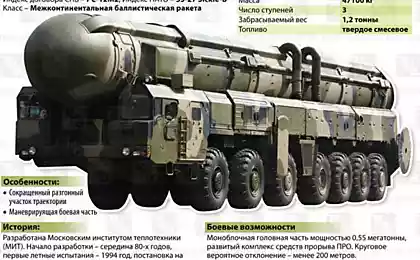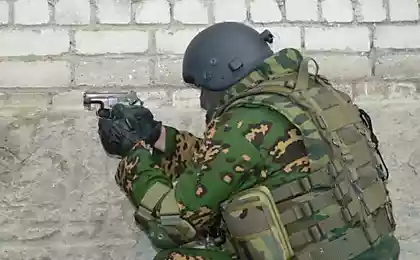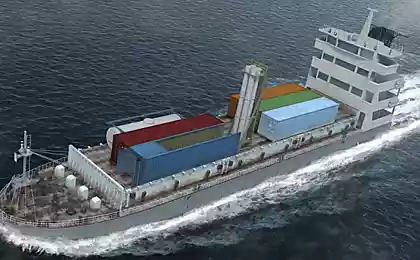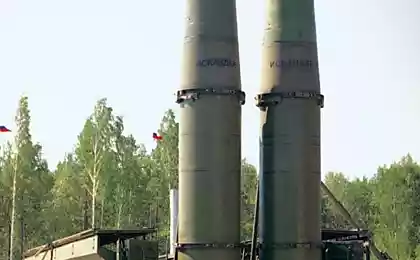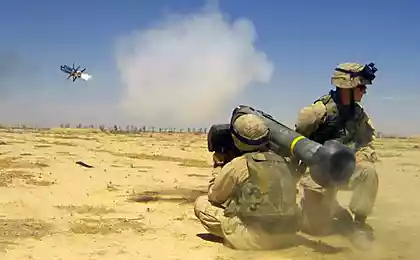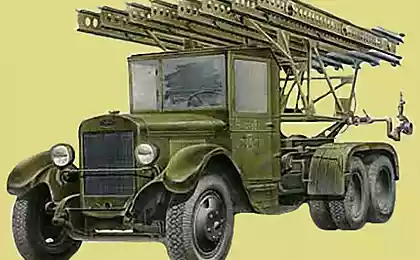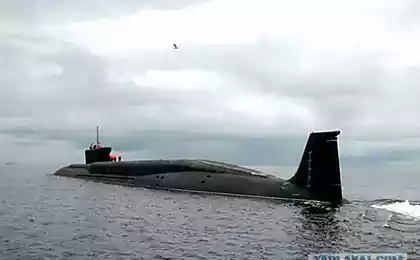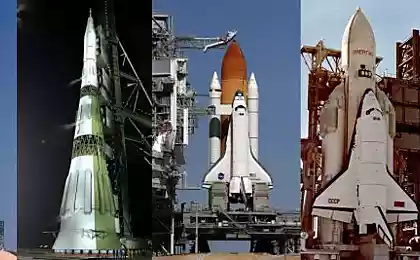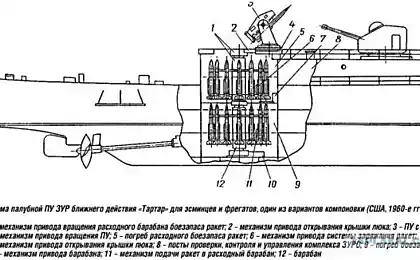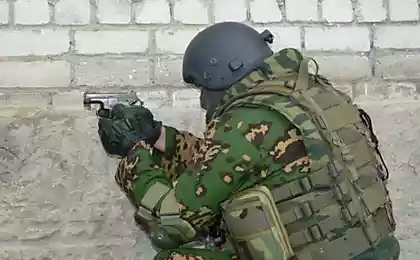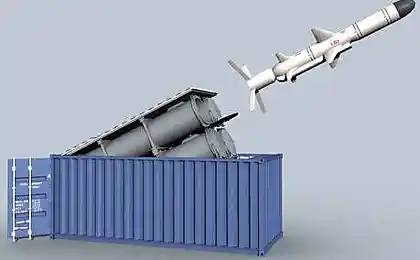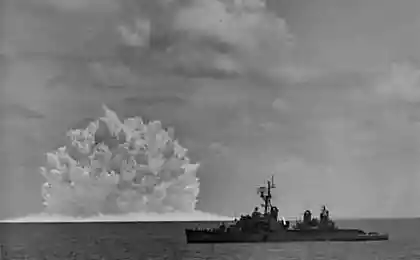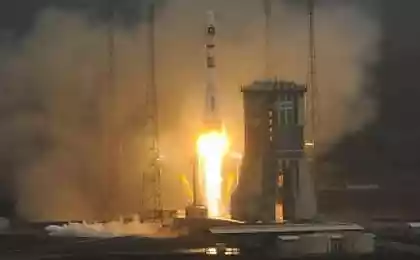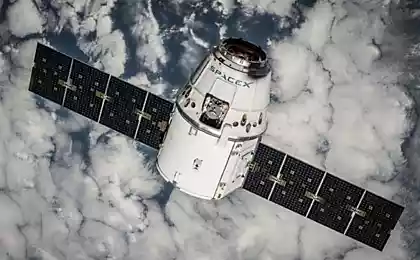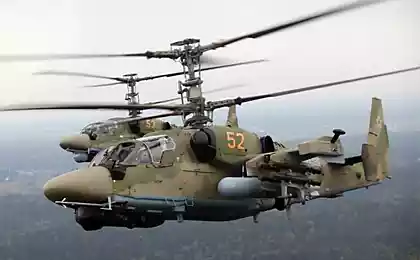587
The most powerful nuclear missiles
6 August 1945 the first nuclear weapon was used against the Japanese city of Hiroshima. Three days later the city of Nagasaki was subjected to the second impact, and currently the last in the history of mankind. The bombing has tried to justify the fact that they ended the war with Japan and prevent further loss of millions of lives.
In total, two bombs killed approximately 240,000 people and proclaimed the beginning of a new, nuclear age. From 1945 until the collapse of the Soviet Union in 1991, the world has survived the cold war and the constant anticipation of possible nuclear attack between the United States and the Soviet Union.
At this time, hand built thousands of nuclear weapons, from small bombs and cruise missiles, for larger warheads of Intercontinental ballistic (ICBM) and Sea-launched ballistic missiles (SLBM). Britain, France and China added to this stock of weapons their own nuclear arsenals. Today, the fear of nuclear annihilation is much less than in the 1970s, but several countries still have a large Arsenal of destructive weapons.
Despite the agreement, aimed at limiting the number of missiles and nuclear powers continue to develop and improve their stocks and methods of delivery. Progress in the development of missile defense systems has led some countries to increase the development of new and more effective missiles.
There was a threat of a new arms race between the world's superpowers. This list contains ten of the most devastating nuclear missile systems currently in service in the world. The accuracy, range, number of warheads, warhead power and movement — factors which make these systems so destructive and dangerous.
This list is presented in no particular order, because these nuclear missiles do not always share the same task or goal. One missile can be designed to destroy the city, while the other type can be designed to destroy enemy missile silos. In addition, this list does not include missiles, currently being tested, or not officially deployed.
Thus, the missile system Agni-V in India and the JL-2 in China, tested step by step and ready for operation this year, are not included. The Jericho III, Israel has also not taken into account, because of this rocket is quite well known. It is important to keep in mind when reading this list that the size of the bombs of Hiroshima and Nagasaki was equivalent to 16 kilotons (x1000) and 21 kiloton of TNT, respectively.
M51, France
After the United States and Russia, France deploys the third largest nuclear Arsenal in the world. In addition to nuclear bombs and cruise missiles, France relies on its SLBM, as the main nuclear deterrent. The M51 missile, the most modern component. She entered service in 2010 and it is currently installed on the Triomphant class submarines. The missile has a range of around 10,000 km and is capable of transferring 6 — 10 warheads of 100 kt. Circular error probable (CEP) of the missile observed between 150 and 200 meters. This means that the warheads have a 50% chance of a strike within 150-200 meters from the target. M51 is equipped with many systems that significantly complicate attempts to intercept warheads.
The DF-31/31A, China's Dong Feng 31 is road-mobile Intercontinental and bunker system series of ICBMs deployed by China since 2006. The original model of this missile carried a large warhead of 1 megaton and had a range of 8,000 km. the Probable deviation of the rocket — 300 m. Improved 31 A has three 150 kt warheads and is able to cover a distance of 11,000 km, with a probable deviation of 150 m. the Additional fact that these missiles can be moved and launched from a mobile rocket carrier, which makes them even more dangerous.
Topol-M, Russia Known as the SS-27 by NATO, the Topol-M was introduced in Russia in 1997. The Intercontinental missile is based in silos, but some Poplars mobile. Currently, the missile is armed with a single warhead with a 800 kt, but can be equipped with up to six warheads and false targets. With a maximum speed of 7.3 kilometers per second, a relatively flat flight path and possible deviation of approx 200 m, Topol-M is a very efficient nuclear rocket, which is difficult to stop in flight. The difficulty of tracking the mobile units makes it a more effective weapon system worthy of this list.
RS-24 YARS, Russia the Bush Administration's Plans to develop a network of missile defense in Eastern Europe angered leaders in the Kremlin. Despite the statement that the screen protects against external impacts is not intended against Russia, the Russian leaders considered it as a threat to their own security and decided to develop a new ballistic missile. The result was the development of the RS-24 YARS. This missile is closely related Topol-M, but delivers four warheads at 150-300 kilotons and has a deviation of 50 m. Featuring many of the characteristics of the Topol, YARS can also change direction in the air and carries decoys, which makes the interception of a missile defense system is extremely difficult.
LGM-30G Minuteman III, the United States Is the only land-based ICBMs, deployed USA. First deployed in 1970, the LGM-30G Minuteman III was to be replaced by the MX Peacekeeper. That program was cancelled, and instead, the Pentagon has spent $7 billion on the upgrade and modernization of existing Active systems 450 LGM-30G for the past decade. At a speed of nearly 8 km/s and a deviation of less than 200 m (the exact number is classified) of the old Minuteman remains a formidable nuclear weapons. Initially, the rocket delivered three small warheads. Today, however, use a single warhead in 300-475 kt.
RSM 56 Bulava, a Russian Naval ballistic missile RSM 56 Bulava is adopted from Russia. From the point of view of sea missiles of the Soviet Union and Russia has fallen behind the United States in the efficiency and abilities. To correct this defect, was created Mace — a more recent addition to the Russian submarine Arsenal. The missile was developed for the new submarines of the Borey-class. After numerous setbacks during the testing phase, Russia adopted the rocket into service in 2013. Mace is currently equipped with six 150 kt warheads, although reports say that it can carry as many as 10. Like most modern ballistic missiles RSM 56 carries a couple of decoys to improve viability in the face of a missile defense system. Range is approximately 8,000 km fully loaded, with approximate probability of deviation of 300-350 meters.
The R-29RMU2 Layner, Russia the Latest development in Russian armaments, the ship was put into operation in 2014. The rocket is effectively an updated version of the previous Russian SLBMs (Sineva R-29RMU2), designed to compensate for certain shortcomings of the Mace. The liner has a range of 11,000 km and can carry a maximum of twelve warheads of 100 kilotons each. Cargo warheads can be reduced and replaced with decoys to improve viability. Deviation warheads kept secret, but probably similar to the 350 m Mace.
UGM-133 Trident II SLBMs, the U.S. Current American and British submarine forces — Trident II. The missile was commissioned in 1990 and has been updated and upgraded since then. Fully equipped, Trident can carry 14 warheads on Board. Later this number reduced and the missile at present delivers 4-5 warheads of 475 kt. The maximum range depends on the load of warheads and ranges between 7800 and 11,000 km, the US Navy demanded the probability of deviations is not more than 120 meters below the missile was adopted for service. Numerous reports and military journals often claim that in fact the deviation of the Trident has exceeded this requirement at a fairly significant rate.
DF-5/5A, China compared to other missiles in this list, the Chinese DF-5/5A can be considered a gray workhorse. The rocket is not allocated nor appearance, nor a difficulty, but it is able to perform any task. The DF-5 entered service in 1981, as a message to any potential enemies that China does not plan pre-emptive strikes, but to punish any who dare attack him. This ICBM can carry a huge 5 MT warhead and has a range of more than 12,000 km DF-5 deviation of about 1 km, which means that the rocket has one goal – to destroy the city. The size of the warhead, the deviation and the fact that its full preparation to launch requires just an hour, all this means that DF-5 is a punitive weapon, designed to punish any potential attackers. Version 5A has an increased range, improved rejection of 300 m and the ability to carry multiple warheads.
R-36M2 "Voevoda" R-36M2 "Voivode" — the rocket that the West was referred to as Satan and this is for good reason. First deployed in 1974, developed in Dnipropetrovsk complex of R-36 has passed since many changes, including the transfer of the warheads. Last modification of this missile, R-36M2, can carry ten 750 kt warheads and has a range of approximately 11,000 km With a maximum speed of nearly 8 km/s and the probable deviation of 220 m, the Satan is a weapon that has caused great concern to American military planners. Anxiety would be much greater if the Soviet planners gave the green light to deploy one version of this rocket, which was supposed to be 38 warheads of 250 kt. Russia plans to withdraw from the use of these missiles by 2019.
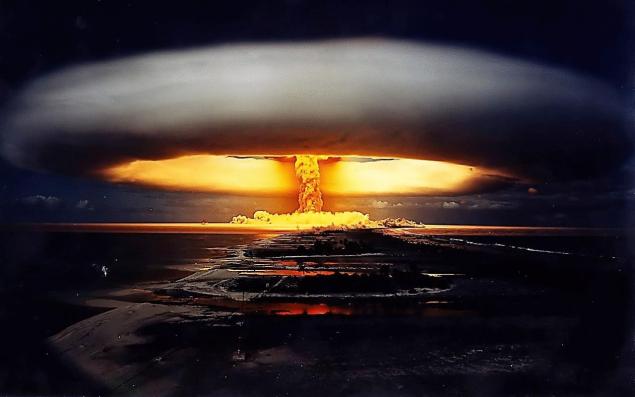
Source: lifeglobe.net/
In total, two bombs killed approximately 240,000 people and proclaimed the beginning of a new, nuclear age. From 1945 until the collapse of the Soviet Union in 1991, the world has survived the cold war and the constant anticipation of possible nuclear attack between the United States and the Soviet Union.
At this time, hand built thousands of nuclear weapons, from small bombs and cruise missiles, for larger warheads of Intercontinental ballistic (ICBM) and Sea-launched ballistic missiles (SLBM). Britain, France and China added to this stock of weapons their own nuclear arsenals. Today, the fear of nuclear annihilation is much less than in the 1970s, but several countries still have a large Arsenal of destructive weapons.
Despite the agreement, aimed at limiting the number of missiles and nuclear powers continue to develop and improve their stocks and methods of delivery. Progress in the development of missile defense systems has led some countries to increase the development of new and more effective missiles.
There was a threat of a new arms race between the world's superpowers. This list contains ten of the most devastating nuclear missile systems currently in service in the world. The accuracy, range, number of warheads, warhead power and movement — factors which make these systems so destructive and dangerous.
This list is presented in no particular order, because these nuclear missiles do not always share the same task or goal. One missile can be designed to destroy the city, while the other type can be designed to destroy enemy missile silos. In addition, this list does not include missiles, currently being tested, or not officially deployed.
Thus, the missile system Agni-V in India and the JL-2 in China, tested step by step and ready for operation this year, are not included. The Jericho III, Israel has also not taken into account, because of this rocket is quite well known. It is important to keep in mind when reading this list that the size of the bombs of Hiroshima and Nagasaki was equivalent to 16 kilotons (x1000) and 21 kiloton of TNT, respectively.
M51, France
After the United States and Russia, France deploys the third largest nuclear Arsenal in the world. In addition to nuclear bombs and cruise missiles, France relies on its SLBM, as the main nuclear deterrent. The M51 missile, the most modern component. She entered service in 2010 and it is currently installed on the Triomphant class submarines. The missile has a range of around 10,000 km and is capable of transferring 6 — 10 warheads of 100 kt. Circular error probable (CEP) of the missile observed between 150 and 200 meters. This means that the warheads have a 50% chance of a strike within 150-200 meters from the target. M51 is equipped with many systems that significantly complicate attempts to intercept warheads.
The DF-31/31A, China's Dong Feng 31 is road-mobile Intercontinental and bunker system series of ICBMs deployed by China since 2006. The original model of this missile carried a large warhead of 1 megaton and had a range of 8,000 km. the Probable deviation of the rocket — 300 m. Improved 31 A has three 150 kt warheads and is able to cover a distance of 11,000 km, with a probable deviation of 150 m. the Additional fact that these missiles can be moved and launched from a mobile rocket carrier, which makes them even more dangerous.
Topol-M, Russia Known as the SS-27 by NATO, the Topol-M was introduced in Russia in 1997. The Intercontinental missile is based in silos, but some Poplars mobile. Currently, the missile is armed with a single warhead with a 800 kt, but can be equipped with up to six warheads and false targets. With a maximum speed of 7.3 kilometers per second, a relatively flat flight path and possible deviation of approx 200 m, Topol-M is a very efficient nuclear rocket, which is difficult to stop in flight. The difficulty of tracking the mobile units makes it a more effective weapon system worthy of this list.
RS-24 YARS, Russia the Bush Administration's Plans to develop a network of missile defense in Eastern Europe angered leaders in the Kremlin. Despite the statement that the screen protects against external impacts is not intended against Russia, the Russian leaders considered it as a threat to their own security and decided to develop a new ballistic missile. The result was the development of the RS-24 YARS. This missile is closely related Topol-M, but delivers four warheads at 150-300 kilotons and has a deviation of 50 m. Featuring many of the characteristics of the Topol, YARS can also change direction in the air and carries decoys, which makes the interception of a missile defense system is extremely difficult.
LGM-30G Minuteman III, the United States Is the only land-based ICBMs, deployed USA. First deployed in 1970, the LGM-30G Minuteman III was to be replaced by the MX Peacekeeper. That program was cancelled, and instead, the Pentagon has spent $7 billion on the upgrade and modernization of existing Active systems 450 LGM-30G for the past decade. At a speed of nearly 8 km/s and a deviation of less than 200 m (the exact number is classified) of the old Minuteman remains a formidable nuclear weapons. Initially, the rocket delivered three small warheads. Today, however, use a single warhead in 300-475 kt.
RSM 56 Bulava, a Russian Naval ballistic missile RSM 56 Bulava is adopted from Russia. From the point of view of sea missiles of the Soviet Union and Russia has fallen behind the United States in the efficiency and abilities. To correct this defect, was created Mace — a more recent addition to the Russian submarine Arsenal. The missile was developed for the new submarines of the Borey-class. After numerous setbacks during the testing phase, Russia adopted the rocket into service in 2013. Mace is currently equipped with six 150 kt warheads, although reports say that it can carry as many as 10. Like most modern ballistic missiles RSM 56 carries a couple of decoys to improve viability in the face of a missile defense system. Range is approximately 8,000 km fully loaded, with approximate probability of deviation of 300-350 meters.
The R-29RMU2 Layner, Russia the Latest development in Russian armaments, the ship was put into operation in 2014. The rocket is effectively an updated version of the previous Russian SLBMs (Sineva R-29RMU2), designed to compensate for certain shortcomings of the Mace. The liner has a range of 11,000 km and can carry a maximum of twelve warheads of 100 kilotons each. Cargo warheads can be reduced and replaced with decoys to improve viability. Deviation warheads kept secret, but probably similar to the 350 m Mace.
UGM-133 Trident II SLBMs, the U.S. Current American and British submarine forces — Trident II. The missile was commissioned in 1990 and has been updated and upgraded since then. Fully equipped, Trident can carry 14 warheads on Board. Later this number reduced and the missile at present delivers 4-5 warheads of 475 kt. The maximum range depends on the load of warheads and ranges between 7800 and 11,000 km, the US Navy demanded the probability of deviations is not more than 120 meters below the missile was adopted for service. Numerous reports and military journals often claim that in fact the deviation of the Trident has exceeded this requirement at a fairly significant rate.
DF-5/5A, China compared to other missiles in this list, the Chinese DF-5/5A can be considered a gray workhorse. The rocket is not allocated nor appearance, nor a difficulty, but it is able to perform any task. The DF-5 entered service in 1981, as a message to any potential enemies that China does not plan pre-emptive strikes, but to punish any who dare attack him. This ICBM can carry a huge 5 MT warhead and has a range of more than 12,000 km DF-5 deviation of about 1 km, which means that the rocket has one goal – to destroy the city. The size of the warhead, the deviation and the fact that its full preparation to launch requires just an hour, all this means that DF-5 is a punitive weapon, designed to punish any potential attackers. Version 5A has an increased range, improved rejection of 300 m and the ability to carry multiple warheads.
R-36M2 "Voevoda" R-36M2 "Voivode" — the rocket that the West was referred to as Satan and this is for good reason. First deployed in 1974, developed in Dnipropetrovsk complex of R-36 has passed since many changes, including the transfer of the warheads. Last modification of this missile, R-36M2, can carry ten 750 kt warheads and has a range of approximately 11,000 km With a maximum speed of nearly 8 km/s and the probable deviation of 220 m, the Satan is a weapon that has caused great concern to American military planners. Anxiety would be much greater if the Soviet planners gave the green light to deploy one version of this rocket, which was supposed to be 38 warheads of 250 kt. Russia plans to withdraw from the use of these missiles by 2019.

Source: lifeglobe.net/
